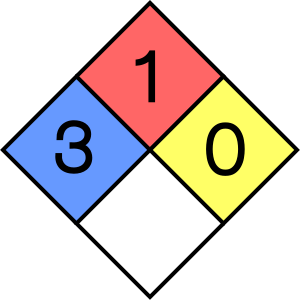CHLORAMPHENICOL
Basic information
- Chemical formula(s): \({\rm C_{11}H_{12}Cl_2N_2O_5}\)
- Other names: D-(-)-threo-2,2-dichloro-N-[β-hydroxy-α-(hydroxymethyl)-p-nitrophenethyl]acetamide
- CAS number: 56-75-7
- EC number: 200-287-4
- Molecular weight: 323.13 g/mol
- International Chemical Safety Card (ICSC): N/A (see Roth Safety Data Sheet)
- Flammability: no
- Description: White or grayish-white crystalline powder. Antibiotic compound. Classified as IARC Group 2A (probably carcinogenic, mutagenic or reprotoxic to humans).
NFPA 704 (fire diamond)

- Health (blue): 3 - short exposure could cause serious temporary or moderate residual injury.
- Flammability (red): 1 - must be pre-heated before ignition can occur under typical fire conditions.
- Instability–reactivity (yellow): 0 - normally stable, even under fire exposure conditions, and is not reactive with water.
- Special notice (white): -
Hazard statements
| Code | Phrase |
|---|---|
| H318 | Causes serious eye damage |
| H351 | Suspected of causing cancer |
| H361fd | Suspected of damaging fertility. Suspected of damaging the unborn child. |
Precautionary statements
| Code | Phrase |
|---|---|
| P202 | Do not handle until all safety precautions have been read and understood |
| P280 | Wear protective gloves/eye protection |
| P305+P351+P338 | IF IN EYES: Rinse cautiously with water for several minutes. Remove contact lenses, if present and easy to do. Continue rinsing |
| P308+P313 | IF exposed or concerned: Get medical advice/attention |
Protective measures
Gloves
For handling chloramphenicol powder (carcinogenic substance):
- Nitrile: very good - recommended for handling carcinogenic materials, chemical resistant.
- Butyl rubber: very good - excellent chemical resistance for extended contact with carcinogens.
- Viton™: very good - superior chemical resistance for hazardous substances.
- Natural latex or rubber: poor (not recommended) - inadequate protection against carcinogens.
- PVC: fair - limited protection, not recommended for carcinogens.
Safety goggles
- Mandatory: Always wear chemical safety goggles when handling this product.
- Use eye protection equipment that has been tested and approved by recognized national standards.
- Corrective glasses are not considered safety goggles.
- Handle only in well-ventilated areas or fume hood.
Clothing
- Mandatory protective clothing: Wear chemical resistant protective clothing.
- Long sleeves and full-length pants required.
- Closed-toe shoes mandatory.
- Disposable clothing recommended when handling carcinogenic materials.
- Remove contaminated clothing immediately and dispose properly.
- Do not take contaminated clothing home.
Respiratory protection
- Mandatory: Use appropriate respiratory protection when handling.
- Use HEPA-filtered respirator or work in fume hood.
- Minimize dust generation during handling.
- Ensure adequate ventilation with HEPA or charcoal filtration.
- Never eat, drink, or smoke while handling.
Spill management
- Evacuate area and restrict access to trained personnel only.
- Wear full protective equipment including respirator.
- Minimize dust generation - do not sweep dry material.
- Use wet cleanup methods or vacuum with HEPA filter.
- Collect material in sealed containers labeled for carcinogenic waste.
- Special disposal required - handle as hazardous carcinogenic waste.
- Decontaminate area thoroughly after cleanup.
- Never wash down drains or dispose in regular waste.
Special warnings
- IARC Group 2A carcinogen - probable human carcinogen.
- Suspected reproductive toxin - may damage fertility or unborn child.
- Causes aplastic anemia - potentially fatal blood disorder.
- Organ damage - causes damage through prolonged or repeated exposure.
- Restricted use - handle only by trained personnel with appropriate safety measures.
- Store in locked, secure area away from unauthorized personnel.
- Medical surveillance required for personnel with occupational exposure.
- Keep exposure logs and provide medical monitoring.
- Pregnancy warning - pregnant or breastfeeding women should not handle.
- Use only in well-ventilated areas with HEPA filtration.
- Emergency procedures - have emergency eyewash and shower available.
- Special training required before handling this carcinogenic substance.